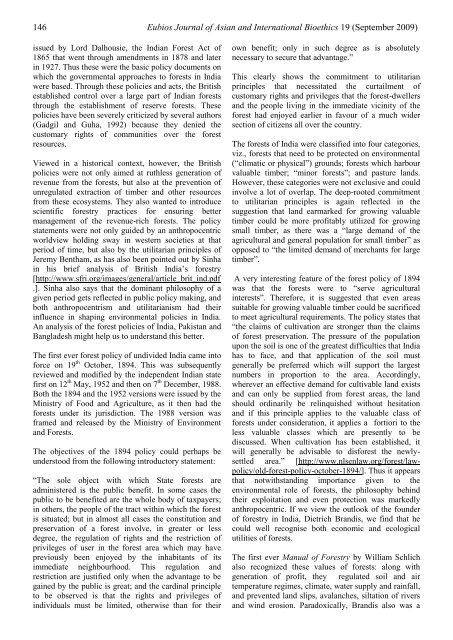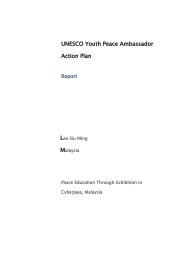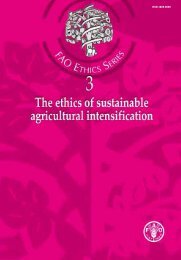Eubios Journal of Asian and International Bioethics EJAIB
Eubios Journal of Asian and International Bioethics EJAIB
Eubios Journal of Asian and International Bioethics EJAIB
You also want an ePaper? Increase the reach of your titles
YUMPU automatically turns print PDFs into web optimized ePapers that Google loves.
146 <strong>Eubios</strong> <strong>Journal</strong> <strong>of</strong> <strong>Asian</strong> <strong>and</strong> <strong>International</strong> <strong>Bioethics</strong> 19 (September 2009)<br />
issued by Lord Dalhousie, the Indian Forest Act <strong>of</strong><br />
1865 that went through amendments in 1878 <strong>and</strong> later<br />
in 1927. Thus these were the basic policy documents on<br />
which the governmental approaches to forests in India<br />
were based. Through these policies <strong>and</strong> acts, the British<br />
established control over a large part <strong>of</strong> Indian forests<br />
through the establishment <strong>of</strong> reserve forests. These<br />
policies have been severely criticized by several authors<br />
(Gadgil <strong>and</strong> Guha, 1992) because they denied the<br />
customary rights <strong>of</strong> communities over the forest<br />
resources.<br />
Viewed in a historical context, however, the British<br />
policies were not only aimed at ruthless generation <strong>of</strong><br />
revenue from the forests, but also at the prevention <strong>of</strong><br />
unregulated extraction <strong>of</strong> timber <strong>and</strong> other resources<br />
from these ecosystems. They also wanted to introduce<br />
scientific forestry practices for ensuring better<br />
management <strong>of</strong> the revenue-rich forests. The policy<br />
statements were not only guided by an anthropocentric<br />
worldview holding sway in western societies at that<br />
period <strong>of</strong> time, but also by the utilitarian principles <strong>of</strong><br />
Jeremy Bentham, as has also been pointed out by Sinha<br />
in his brief analysis <strong>of</strong> British India‟s forestry<br />
[http://www.sfri.org/images/general/article_brit_ind.pdf<br />
.]. Sinha also says that the dominant philosophy <strong>of</strong> a<br />
given period gets reflected in public policy making, <strong>and</strong><br />
both anthropocentrism <strong>and</strong> utilitarianism had their<br />
influence in shaping environmental policies in India.<br />
An analysis <strong>of</strong> the forest policies <strong>of</strong> India, Pakistan <strong>and</strong><br />
Bangladesh might help us to underst<strong>and</strong> this better.<br />
The first ever forest policy <strong>of</strong> undivided India came into<br />
force on 19 th October, 1894. This was subsequently<br />
reviewed <strong>and</strong> modified by the independent Indian state<br />
first on 12 th May, 1952 <strong>and</strong> then on 7 th December, 1988.<br />
Both the 1894 <strong>and</strong> the 1952 versions were issued by the<br />
Ministry <strong>of</strong> Food <strong>and</strong> Agriculture, as it then had the<br />
forests under its jurisdiction. The 1988 version was<br />
framed <strong>and</strong> released by the Ministry <strong>of</strong> Environment<br />
<strong>and</strong> Forests.<br />
The objectives <strong>of</strong> the 1894 policy could perhaps be<br />
understood from the following introductory statement:<br />
“The sole object with which State forests are<br />
administered is the public benefit. In some cases the<br />
public to be benefited are the whole body <strong>of</strong> taxpayers;<br />
in others, the people <strong>of</strong> the tract within which the forest<br />
is situated; but in almost all cases the constitution <strong>and</strong><br />
preservation <strong>of</strong> a forest involve, in greater or less<br />
degree, the regulation <strong>of</strong> rights <strong>and</strong> the restriction <strong>of</strong><br />
privileges <strong>of</strong> user in the forest area which may have<br />
previously been enjoyed by the inhabitants <strong>of</strong> its<br />
immediate neighbourhood. This regulation <strong>and</strong><br />
restriction are justified only when the advantage to be<br />
gained by the public is great; <strong>and</strong> the cardinal principle<br />
to be observed is that the rights <strong>and</strong> privileges <strong>of</strong><br />
individuals must be limited, otherwise than for their<br />
own benefit; only in such degree as is absolutely<br />
necessary to secure that advantage.”<br />
This clearly shows the commitment to utilitarian<br />
principles that necessitated the curtailment <strong>of</strong><br />
customary rights <strong>and</strong> privileges that the forest-dwellers<br />
<strong>and</strong> the people living in the immediate vicinity <strong>of</strong> the<br />
forest had enjoyed earlier in favour <strong>of</strong> a much wider<br />
section <strong>of</strong> citizens all over the country.<br />
The forests <strong>of</strong> India were classified into four categories,<br />
viz., forests that need to be protected on environmental<br />
(“climatic or physical”) grounds; forests which harbour<br />
valuable timber; “minor forests”; <strong>and</strong> pasture l<strong>and</strong>s.<br />
However, these categories were not exclusive <strong>and</strong> could<br />
involve a lot <strong>of</strong> overlap. The deep-rooted commitment<br />
to utilitarian principles is again reflected in the<br />
suggestion that l<strong>and</strong> earmarked for growing valuable<br />
timber could be more pr<strong>of</strong>itably utilized for growing<br />
small timber, as there was a “large dem<strong>and</strong> <strong>of</strong> the<br />
agricultural <strong>and</strong> general population for small timber” as<br />
opposed to “the limited dem<strong>and</strong> <strong>of</strong> merchants for large<br />
timber”.<br />
A very interesting feature <strong>of</strong> the forest policy <strong>of</strong> 1894<br />
was that the forests were to “serve agricultural<br />
interests”. Therefore, it is suggested that even areas<br />
suitable for growing valuable timber could be sacrificed<br />
to meet agricultural requirements. The policy states that<br />
“the claims <strong>of</strong> cultivation are stronger than the claims<br />
<strong>of</strong> forest preservation. The pressure <strong>of</strong> the population<br />
upon the soil is one <strong>of</strong> the greatest difficulties that India<br />
has to face, <strong>and</strong> that application <strong>of</strong> the soil must<br />
generally be preferred which will support the largest<br />
numbers in proportion to the area. Accordingly,<br />
wherever an effective dem<strong>and</strong> for cultivable l<strong>and</strong> exists<br />
<strong>and</strong> can only be supplied from forest areas, the l<strong>and</strong><br />
should ordinarily be relinquished without hesitation<br />
<strong>and</strong> if this principle applies to the valuable class <strong>of</strong><br />
forests under consideration, it applies a fortiori to the<br />
less valuable classes which are presently to be<br />
discussed. When cultivation has been established, it<br />
will generally be advisable to disforest the newlysettled<br />
area.” [http://www.nlsenlaw.org/forest/lawpolicy/old-forest-policy-october-1894/].<br />
Thus it appears<br />
that notwithst<strong>and</strong>ing importance given to the<br />
environmental role <strong>of</strong> forests, the philosophy behind<br />
their exploitation <strong>and</strong> even protection was markedly<br />
anthropocentric. If we view the outlook <strong>of</strong> the founder<br />
<strong>of</strong> forestry in India, Dietrich Br<strong>and</strong>is, we find that he<br />
could well recognise both economic <strong>and</strong> ecological<br />
utilities <strong>of</strong> forests.<br />
The first ever Manual <strong>of</strong> Forestry by William Schlich<br />
also recognized these values <strong>of</strong> forests: along with<br />
generation <strong>of</strong> pr<strong>of</strong>it, they regulated soil <strong>and</strong> air<br />
temperature regimes, climate, water supply <strong>and</strong> rainfall,<br />
<strong>and</strong> prevented l<strong>and</strong> slips, avalanches, siltation <strong>of</strong> rivers<br />
<strong>and</strong> wind erosion. Paradoxically, Br<strong>and</strong>is also was a

















